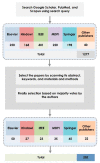Role of Artificial Intelligence in COVID-19 Detection
- PMID: 34884045
- PMCID: PMC8659534
- DOI: 10.3390/s21238045
Role of Artificial Intelligence in COVID-19 Detection
Abstract
The global pandemic of coronavirus disease (COVID-19) has caused millions of deaths and affected the livelihood of many more people. Early and rapid detection of COVID-19 is a challenging task for the medical community, but it is also crucial in stopping the spread of the SARS-CoV-2 virus. Prior substantiation of artificial intelligence (AI) in various fields of science has encouraged researchers to further address this problem. Various medical imaging modalities including X-ray, computed tomography (CT) and ultrasound (US) using AI techniques have greatly helped to curb the COVID-19 outbreak by assisting with early diagnosis. We carried out a systematic review on state-of-the-art AI techniques applied with X-ray, CT, and US images to detect COVID-19. In this paper, we discuss approaches used by various authors and the significance of these research efforts, the potential challenges, and future trends related to the implementation of an AI system for disease detection during the COVID-19 pandemic.
Keywords: artificial intelligence; computer-aided diagnostic tool; deep neural networks; hand-crafted feature learning; supervised learning.
Conflict of interest statement
The authors declare no conflict of interest.
Figures








Similar articles
-
Signs and symptoms to determine if a patient presenting in primary care or hospital outpatient settings has COVID-19.Cochrane Database Syst Rev. 2022 May 20;5(5):CD013665. doi: 10.1002/14651858.CD013665.pub3. Cochrane Database Syst Rev. 2022. PMID: 35593186 Free PMC article.
-
Antibody tests for identification of current and past infection with SARS-CoV-2.Cochrane Database Syst Rev. 2022 Nov 17;11(11):CD013652. doi: 10.1002/14651858.CD013652.pub2. Cochrane Database Syst Rev. 2022. PMID: 36394900 Free PMC article.
-
Measures implemented in the school setting to contain the COVID-19 pandemic.Cochrane Database Syst Rev. 2022 Jan 17;1(1):CD015029. doi: 10.1002/14651858.CD015029. Cochrane Database Syst Rev. 2022. Update in: Cochrane Database Syst Rev. 2024 May 2;5:CD015029. doi: 10.1002/14651858.CD015029.pub2. PMID: 35037252 Free PMC article. Updated.
-
Non-pharmacological measures implemented in the setting of long-term care facilities to prevent SARS-CoV-2 infections and their consequences: a rapid review.Cochrane Database Syst Rev. 2021 Sep 15;9(9):CD015085. doi: 10.1002/14651858.CD015085.pub2. Cochrane Database Syst Rev. 2021. PMID: 34523727 Free PMC article.
-
The COVID-19 epidemic analysis and diagnosis using deep learning: A systematic literature review and future directions.Comput Biol Med. 2022 Feb;141:105141. doi: 10.1016/j.compbiomed.2021.105141. Epub 2021 Dec 14. Comput Biol Med. 2022. PMID: 34929464 Free PMC article.
Cited by
-
Artificial intelligence model on chest imaging to diagnose COVID-19 and other pneumonias: A systematic review and meta-analysis.Eur J Radiol Open. 2022;9:100438. doi: 10.1016/j.ejro.2022.100438. Epub 2022 Aug 18. Eur J Radiol Open. 2022. PMID: 35996746 Free PMC article. Review.
-
Ethical and regulatory challenges of AI technologies in healthcare: A narrative review.Heliyon. 2024 Feb 15;10(4):e26297. doi: 10.1016/j.heliyon.2024.e26297. eCollection 2024 Feb 29. Heliyon. 2024. PMID: 38384518 Free PMC article. Review.
-
Novel favipiravir pattern-based learning model for automated detection of specific language impairment disorder using vowels.Neural Comput Appl. 2023;35(8):6065-6077. doi: 10.1007/s00521-022-07999-4. Epub 2022 Nov 13. Neural Comput Appl. 2023. PMID: 36408288 Free PMC article.
-
Computer-aided diagnosis of chest X-ray for COVID-19 diagnosis in external validation study by radiologists with and without deep learning system.Sci Rep. 2023 Oct 16;13(1):17533. doi: 10.1038/s41598-023-44818-9. Sci Rep. 2023. PMID: 37845348 Free PMC article.
-
Generalizability assessment of COVID-19 3D CT data for deep learning-based disease detection.Comput Biol Med. 2022 Jun;145:105464. doi: 10.1016/j.compbiomed.2022.105464. Epub 2022 Apr 1. Comput Biol Med. 2022. PMID: 35390746 Free PMC article.
References
-
- Zhang J., Litvinova M., Wang W., Wang Y., Deng X., Chen X., Li M., Zheng W., Yi L., Chen X., et al. Evolving epidemiology and transmission dynamics of coronavirus disease 2019 outside Hubei province, China: A descriptive and modelling study. Lancet Infect. Dis. 2020;20:793–802. doi: 10.1016/S1473-3099(20)30230-9. - DOI - PMC - PubMed
-
- Cascella M., Rajnik M., Aleem A., Dulebohn S.C., Di Napoli R. Features, Evaluation and Treatment Coronavirus (COVID-19) Stat Pearls Publishing; Treasure Island, FL, USA: 2020. - PubMed
Publication types
MeSH terms
Grants and funding
LinkOut - more resources
Full Text Sources
Medical
Miscellaneous

